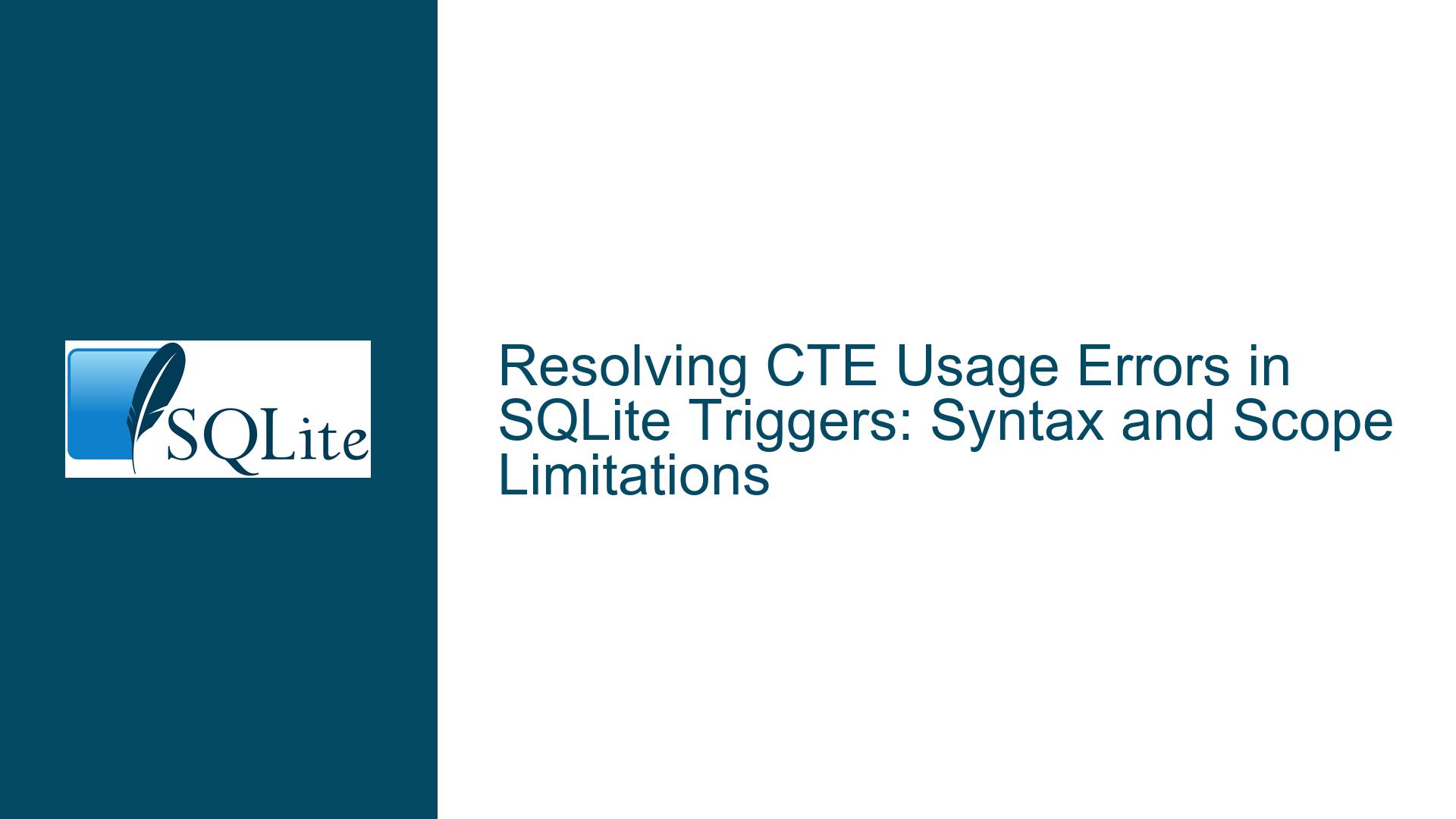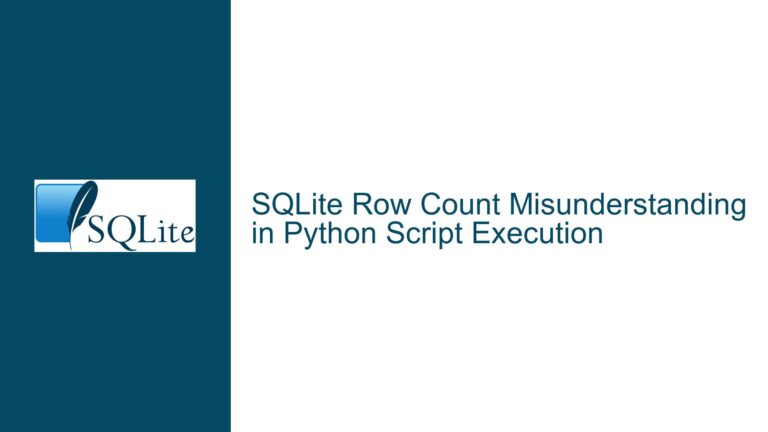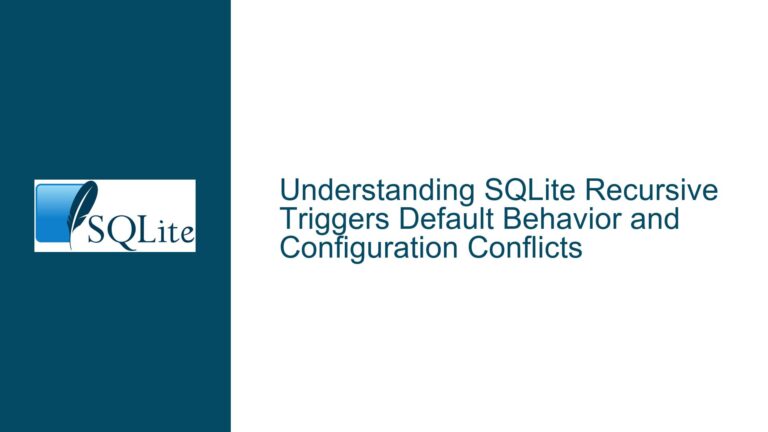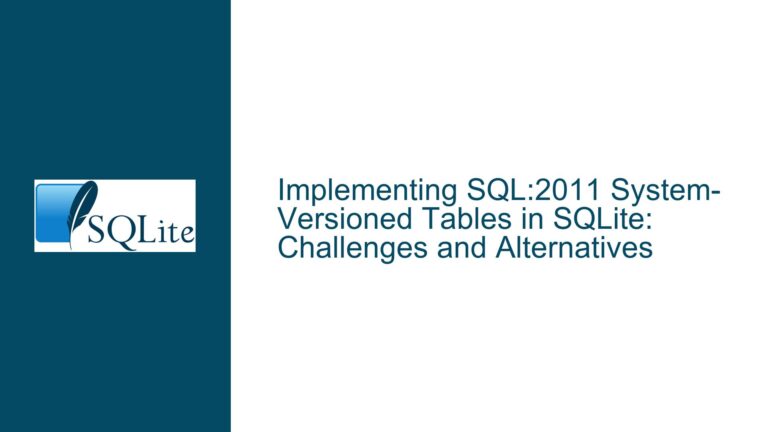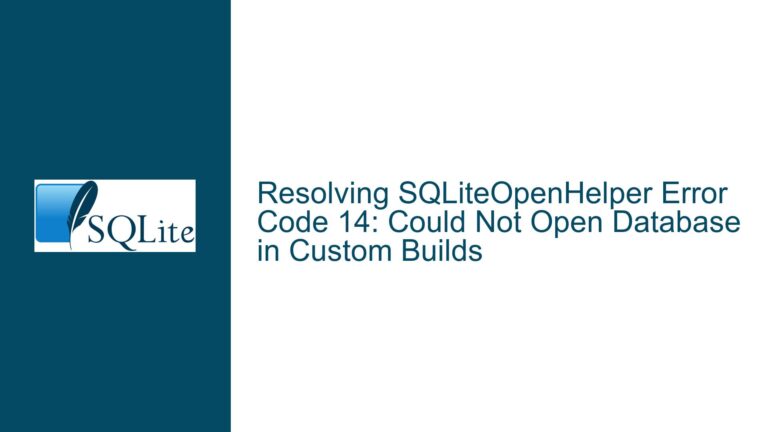Resolving CTE Usage Errors in SQLite Triggers: Syntax and Scope Limitations
Issue Overview: Syntax Conflicts When Using Common Table Expressions (CTEs) in Triggers
The core problem arises from attempting to use a Common Table Expression (CTE) within an SQLite trigger in a manner that violates SQLite’s syntax rules. The user’s initial code includes a CTE (WITH ARCHIVE_MEASUREMENT ...) followed by an INSERT statement, both defined at the top level of the trigger body. While the parser accepts the CTE when it is part of a standalone SELECT statement, it rejects the same CTE when followed by an INSERT without intervening logic. This inconsistency stems from SQLite’s restrictions on CTE usage in triggers, specifically documented in SQLite’s WITH clause documentation, which states: "The WITH clause cannot be used within a CREATE TRIGGER." However, the user demonstrates a working example where a CTE is embedded within an INSERT statement inside a trigger, suggesting that the restriction applies only to top-level CTEs, not those nested within DML operations.
The confusion arises from two conflicting observations:
- A CTE declared at the trigger’s top level (outside of a DML statement) causes parsing errors.
- A CTE embedded within an
INSERToperation inside the same trigger works without errors.
This discrepancy highlights SQLite’s nuanced treatment of CTEs in triggers. The parser rejects top-level CTEs but permits CTEs that are part of a larger DML statement (e.g., INSERT, SELECT). The user’s first example violates this rule by placing the CTE outside the INSERT, while the second example complies by nesting the CTE within the INSERT.
Possible Causes: Misapplication of CTE Scope and Trigger Execution Context
Three primary factors contribute to this issue:
Top-Level CTE Restrictions in Triggers
SQLite explicitly prohibits the use of CTEs at the top level of a trigger body. A trigger’s code block (betweenBEGINandEND) must consist of valid SQL statements, and standalone CTEs are not recognized as complete statements in this context. For example:CREATE TRIGGER invalid_trigger BEFORE UPDATE ON table1 BEGIN WITH cte AS (SELECT 1) -- Error: Top-level CTE INSERT INTO table2 SELECT * FROM cte; END;This code fails because the
WITHclause is treated as a separate statement, which is unsupported. However, nesting the CTE within theINSERTresolves the issue:CREATE TRIGGER valid_trigger BEFORE UPDATE ON table1 BEGIN INSERT INTO table2 WITH cte AS (SELECT 1) -- Allowed: CTE is part of the INSERT SELECT * FROM cte; END;Parser Ambiguity with CTE Placement
The SQLite parser may fail to distinguish between a top-level CTE and a nested CTE when the trigger’s logic is complex. For instance, the user’s first example uses a CTE followed by anINSERT, separated by a semicolon, which the parser interprets as two distinct statements. The parser rejects this because the first statement (WITH ... SELECT ...) is invalid in a trigger context. Removing the standalone CTE and embedding it within theINSERTavoids this error.Inconsistent Error Reporting Across SQLite Versions
While SQLite 3.45.0 enforces the restriction on top-level CTEs, older versions might exhibit varying behaviors. Additionally, the parser’s error messages may not always clearly indicate the root cause. For example, the user observed that deleting theSELECTstatement after the CTE caused the parser to flag an error at theINSERT, masking the true issue (the invalid CTE placement).
Troubleshooting Steps, Solutions & Fixes: Restructuring Triggers to Comply with CTE Rules
Step 1: Identify Top-Level CTEs in Triggers
Review the trigger’s code to locate any CTEs declared outside of DML statements. For example:
CREATE TRIGGER problematic_trigger
BEFORE UPDATE ON waste_samples
BEGIN
-- Top-level CTE (invalid)
WITH ARCHIVE_MEASUREMENT (...) AS (...)
SELECT * FROM ARCHIVE_MEASUREMENT;
INSERT INTO waste_samples_archive ...;
END;
Here, the WITH clause is a standalone statement, which is invalid. Move the CTE into the INSERT or SELECT operations.
Step 2: Embed CTEs Within DML Statements
Rewrite the trigger to nest CTEs within INSERT, UPDATE, or SELECT statements. For the user’s initial example:
CREATE TRIGGER fixed_trigger
BEFORE UPDATE ON waste_samples
BEGIN
INSERT OR ABORT INTO waste_samples_archive (
RM_Date_of_report,
RM_Date_measurement,
RM_ZI_code,
OLD_NA_flow0,
NEW_NA_flow,
RM_Modification,
RM_Reason
)
WITH ARCHIVE_MEASUREMENT (...) AS (
-- CTE definition
)
SELECT
a.RM_Date_of_report,
a.RM_Date_measurement,
a.RM_ZI_CODE,
a.OLD_NA_flow,
a.NEW_NA_flow,
a.RM_Modification,
CASE ... END
FROM ARCHIVE_MEASUREMENT a;
END;
By embedding the CTE within the INSERT, the parser recognizes it as part of a valid DML statement.
Step 3: Replace CTEs with Temporary Tables (If Necessary)
If the CTE’s logic cannot be nested within a DML statement, use temporary tables to achieve similar results. For example:
CREATE TRIGGER alternative_trigger
BEFORE UPDATE ON waste_samples
BEGIN
-- Create temporary table
DROP TABLE IF EXISTS temp.ARCHIVE_MEASUREMENT;
CREATE TEMP TABLE ARCHIVE_MEASUREMENT AS
SELECT ...;
-- Use temporary table in INSERT
INSERT INTO waste_samples_archive (...)
SELECT ... FROM temp.ARCHIVE_MEASUREMENT;
END;
This approach avoids CTEs entirely while preserving the logic.
Step 4: Validate Trigger Syntax with EXPLAIN
Use SQLite’s EXPLAIN command to test the trigger’s syntax without executing it. For example:
EXPLAIN
CREATE TRIGGER debug_trigger ...;
If the EXPLAIN output shows errors at the WITH clause, revisit the CTE placement.
Step 5: Test Across SQLite Versions
Ensure compatibility by testing the trigger on multiple SQLite versions (e.g., 3.35.0+, where CTE support in DML statements was stabilized). Use the sqlite3_version() function to check the runtime version:
SELECT sqlite3_version();
Step 6: Audit Trigger Logic for Nested CTEs
In complex triggers, verify that all CTEs are scoped to individual DML statements. For instance, the user’s working example uses a CTE within an INSERT:
INSERT INTO _INET_
WITH RECURSIVE SPLIT(...) AS (...) -- Valid: CTE is part of the INSERT
SELECT ... FROM SPLIT;
This pattern complies with SQLite’s rules.
Step 7: Consult SQLite Documentation for Edge Cases
Review SQLite’s trigger documentation and WITH clause notes to confirm allowable CTE contexts. Specifically, note that CTEs in triggers are permitted only when part of a larger DML operation.
By systematically restructuring the trigger to avoid top-level CTEs and embedding them within valid DML statements, users can resolve parsing errors and ensure reliable trigger execution.
